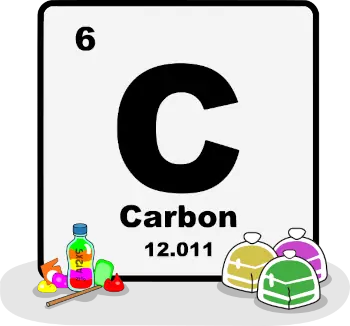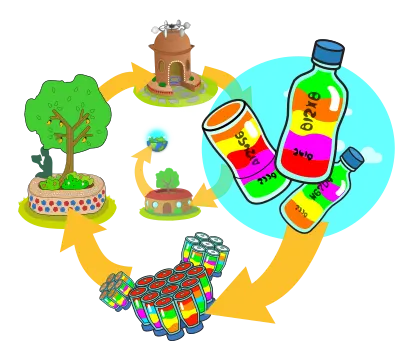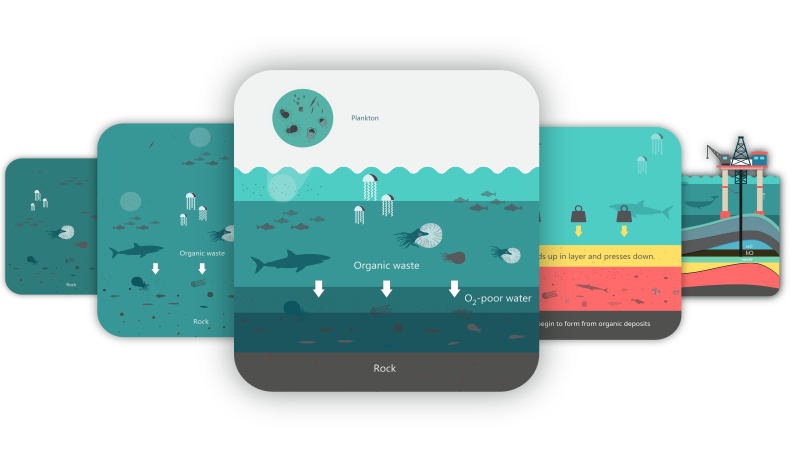The science is clear: Plastic loose in the biosphere harms ecosystems, humans and animals. The research is also clear: For the last fifty years, industrial processing has dispersed plastic into the environment while becoming a major source of carbon emissions.
It has never been more important to take care of our plastic. Plastic sequestration provides a regenerative alternative to industrial plastic management. Following the Earth's example of carbon sequestration, we have a proven path to not only secure our plastic out of the biosphere and out of industry, but also to accelerate our plastic transition. The Global Ecobrick Alliance maintains criteria and standards for plastic sequestration to ensure that it is an authentic ecological service.
Theory & Science
The goal of plastic sequestration is to follow Earth's example of carbon care in preventing the degradation dispersal of plastic into the biosphere— and in keeping it out of industry.
Just as Earth sequestered carbon deep into secure geologic storage to cultivate and green the biosphere, so too can we compact, secure, and sequester our plastic (which itself is mostly carbon). By following the Earth’s example we can be confident our enterprise of plastic management is making a valuable ecological contribution.
We call this prevention of plastic degradation and dispersal, plastic sequestration.
Plastic degradation occurs physically (such as cracking, embrittlement, and flaking) and chemically (such as leaching). Emissions and dispersal occur when plastic is industrially processed through recycling, incineration, and land-filling. In order to prevent these outcomes, plastic sequestration diverts plastic from industry and prevents the chemical and physical degradation of plastic from the effects of light, heat, acids, friction, microbial action, etc.
1. Preventing Degradation
Plastic polymer degradation occurs on the exposed surface area of plastic. Consequently, the rate of degradation is directly proportional to the amount of surface area exposed. Research indicates that a thin film of HDPE plastic (which has a very large surface area) can degrade 1100 times faster than a bead of plastic of the same weight (very small surface area).
By decreasing net surface area, the lifetime of collected plastic can be extended significantly. By further removing exposure to all forms of chemical and physical degradation through appropriate applications, plastic can remain intact indefinitely.
2. Preventing Industrial Emissions
Plastic that enters into industry results in a wide range of energy-intensive activities from transportation to smelting to re-molding. The goal of plastic sequestration is to prevent these emissions.
3. Preventing Industrial Plastic Dispersion
Plastic that enters into industry is inevitably dispersed around the globe. The goal of plastic sequestration is to prevent this dispersion.
4. Preventing Ecological Disruption
Plastic once loose in the biosphere has been shown to interfere with ecological cycles. The goal of plastic sequestration is to prevent these disruptions.
5. Earthen Enclosure
Research has shown that enclosing plastic in earth prevents abiotic plastic degradation. By enclosing the outputs of plastic sequestration in inert, net-zero earthen building materials such as cob and adobe, the outputs of plastic sequestration can be secured.
ℹ️ Learn about: The Long Story of Plastic
ℹ️ Source: Earthen Ethics
Criteria & Standards
A framework to ensure that plastic sequestration is of authentic ecological service.
The Global Ecobrick Alliance, as a third-party Earth enterprise with a mandate of biosphere benefit, has developed a system of criteria and standards for the sequestration of plastic. Our criteria provide a guide for methodologies and technologies aspiring to plastic sequestration.
The Earth's billion year process of carbon sequestration helped green the planet. To ensure that our process of plastic sequestration does the same, we follow the principles of Earth's example. Using them we've established six criteria and associated standards for plastic sequestration.
Our criteria help us all ensure that the enterprise, outputs, and processes of plastic sequestration are in fact an authentic ecological contribution.
Our standards assist enterprises to measure the calibre and quality of their plastic sequestration outputs and processes.
In order for plastic to be considered sequestered, it must not only meet these six criteria and their respective standards, it must also be independently authenticated to have done so.
🌍 Learn more: The Six Earthen Principles
1. Secured Concentration
The process secures plastic from all forms of chemical and physical degradation and from industrial processing.
In the same way that Earth sequestered carbon by concentrating, securing and storing it indefinitely, plastic sequestration must do the same.
The Earth’s cycles steadily led to more and more carbon being secured from all forms of solar, chemical and organic degradation. In the same way, plastic sequestration must concentrate plastic. Keeping plastic as plastic and securing it into long-term, indefinite and secured storage is key to its sequestration.

Keeping plastic that has already been produced as plastic is an effective way to keep its carbon from getting loose.

Plastic degrades quickly when it is exposed to sun, fire, oxygen and/or friction. Its degradation is in proportion to its surface area. As the majority of modern plastic is in the form of thin films, when it is loose and exposed, it is prone to rapid degradation. Plastic degrades by fragmenting into smaller and smaller particles, known as micro-plastics, greenhouse gases, and toxins.
By compacting thin, high-surface area plastic, the net exposed area is reduced a thousand-fold. The GEA has found that reaching a density of 0.33 g/ml achieves a terminal reduction of net surface area for the majority of modern thin film plastics. Once compacted and contained, plastic is secured from degradation and can remain intact indefinitely.
Sequestration Standard
To be considered plastic sequestration, the processing of plastic must achieve the minimum density of 0.33 g/ml and ensure secure, indefinite storage.
🌍 Learn more: The Earthen Principle of Concentration
2. Spiral Design
Outputs are indefinitely reusable and lead to indefinite cycles of reuse.
In the same way that Earth's processes led to the cyclical use of carbon in cycles that spiralled towards sequestration so too must the process of plastic sequestration.
Earth's processes used carbon-based building blocks that were reusable over and over by organisms and ecosystems. Overtime, this biomass tended towards concentration and sequestration under the earth. In the same way, the outputs of plastic sequestration, must intend the same.

As such, plastic sequestration is by-definition a non-industrial process.

Industrial plastic management methods are typically linear. Plastic recycling, incineration, and landfilling spiral plastic towards dispersion. Industrial methods are powered by fossil fuels that are decompacted and burned, loosening their carbon into the atmosphere.
In comparison, Earth has used carbon in circular, cyclical processes. Carbon molecules such as nucleic acids, proteins, lipids, and glycans make up all organisms–and when one organism comes to an end, another begins by building itself with the other’s blocks. This continues indefinitely until the carbon is subsumed into long-term sequestration.
Intending net-green outputs that can be reused indefinitely until they are eventually sequestered in earthen applications is known as spiral design.
Plastic Sequestration Standards
To be considered sequestered, plastic sequestration outputs must be demonstrably reusable. Their application must prevent abiotic and biotic degradation, reducing the specific surface degradation rate (SSDR) of the plastic to below 0.1 μm year–1.
🌍 Learn more: The Earthen Principle of Spiral Cycling
3. For-Earth Enterprise
The process must be conducted as a not-for-profit, for-Earth enterprise.
In the same way that Earth’s processes tend towards the benefit the biosphere, the enterprise of plastic sequestration must intend the same.
At all levels of the biosphere, we can see that its many parts contribute upwards to the benefit of the whole. The cells of a leaf, the leaves of a tree, and the trees of a forests spiral benefits upwards to the whole. In the same way, the enterprise of plastic sequestration must be structured to prioritize the upwards benefit of the whole rather than the downwards benefit of a few.

Industrial methods of plastic processing are driven by for-profit enterprise.

In for-profit enterprise, profit has priority over all other intentions, and spirals benefits downward towards owners and shareholder. This is contrary to the geometry of Earth's ecological systems.
While industrial systems may have the best intentions, they operate within the petro-capital economy. As such they are constrained to its forces. Industrial methods are driven by profit to recover the capital-value of plastic. Once this value is exhausted, plastic is cycled out of industry to the biosphere.
As such, the enterprise of plastic sequestration must be must be not-for-profit and for the biosphere’s benefit.
Plastic Sequestration Standards
Enterprises undertaking the process of plastic sequestration must formally declare their not-for-profit, for-Earth structure.
🌍 Learn more: The Earthen Principle of Biosphere Benefit
4. Net-Subtractive
The process results in the sequestration of more carbon and more plastic than is added through emissions and replacement plastic.
Just as Earth's cycles subtract more carbon from the biosphere than they add, so too must the enterprise of plastic sequestration.
The net result of Earth's cycles has been the subtraction of more carbon from the atmosphere than was added back into it. The steady sequestration of carbon led over time to the greening of the biosphere. In the same way, the enterprise of plastic sequestration must subtract more carbon into secure storage than it emits and adds.
The processing of plastic within industry results in the net-addition of carbon into the atmosphere and the creation of more plastic.
In this way, the enterprise of plastic sequestration must account for its various additive (grey) and subtractive (green) ecological impacts and it must show that the net result of the process is the subtraction of plastic and CO2 from the biosphere. Only when it is net-subtractive can it be considered plastic sequestration.
Plastic Transition Standards
Enterprises publically declare their net-green intention. Enterprises account yearly for their subtractive and additive impacts and ensure that are net-green.
🌍 Learn more: The Earthern Principle of Net-Subtraction
5. Supporting Biodiversity
The process and its outputs support the diversification of life.
In the same way that Earth’s process steadily increased biodiversication, so too must our process of plastic sequestration.
The Earth’s use of carbon enabled life to flourish and diversify. Likewise, the short-term use of sequestered plastic must be such that it supports life in the short term and enables biodiversity in the long-term.

The outputs of plastic sequestration must be intended for applications that support biodiversity.

When sequestration leads to short-term building blocks, these can be used in the creation of green spaces, gardens and food-forests, and the decontamination of plastic polluted areas. Critically, the plastic blocks must be used in such a way that they do not degrade or contaminate and thus impede life.
In the long-term sequestered plastic must be entirely protected from all forms of degradation (heat, light, friction, oxygen, and micro-organism) so that it also does not contaminate and harm life and its diversity.
In contrast, industrial plastic processing relies on factories, facilities, and dump sites that occupy the spaces of what were once fields and forests. These spaces can no longer support the surrounding ecology and result in a net decrease in biodiversity.
Plastic Transition Standards
Outputs of plastic sequestration must be designed for applications that demonstrably support life and its diversification. Plastic sequestration enterprises must track and disclose their net-impact on local biodiversity.
🌍 Learn more:The Earthen Principle of Diversification
6. Awareness Raising
The enterprise tracks and publically discloses all the plastic, carbon and biodiversity impacts of its process.
In the same way that Earth has cultivated ever greater ecological awareness, the enterprise of plastic sequestration must do the same through ecological impact accounting and disclosure.
Earth’s cycles lead to an ever increasing awareness of those impacted in an ecosystem. Plastic sequestration must likewise increase our awareness through an accounting and disclosure of the ecological impacts of the process.

In the past, industrial plastic processing distanced consumers from the ecological consequences of plastic consumption.

Industrial plastic management removes consumer participation and agency in the process. Through long-distance export, the ecological impact of plastic processing is hidden from consumers. By purporting to have a plastic solution, industry has encouraged the unabated consumption of plastic. This has led to a steady increase of plastic consumption, production, and pollution over the last 50 years.
Plastic sequestration must be transparent, open, and accountable. Plastic sequestration must return accurate data to those consuming plastic through an accounting of its ecological impacts near and far.
Only if the process raises individual and collective awareness can it be considered plastic sequestration.
Plastic Transition Standards
The enterprise of plastic sequestration must track and publically disclose in carbon, plastic, and biodiversity impacts.
🌍 Learn more: The Earthen Ethic of Awareness
Independent Authentication
The fulfillment of the above criteria must be independently verified by a not-for-profit, for-Earth third party who does not benefit from the process.
Outputs must be independently validated to authenticate that the criteria of plastic sequestration have been met.
The way that plastic is processed can either harm or benefit the biosphere for centuries. Because the stakes are high, the outputs of plastic sequestration must be validated to make sure that standards and the criteria above are met.

Through independent, not-for-profit review, set amounts of plastic can then be determined to be sequestered (or not).

In this way, authenticated sequestered plastic can then be quantified. Sequestered plastic can then be referred to with confidence in terms of net weight (i.e., X kg of authenticated sequestered plastic).
Just like the process of plastic sequestration itself, the process of authentication must also be not-for-profit and for-earth. Only after an independent review can the outputs net-weight be considered authenticated sequestered plastic.
CO2 Equivalency
Plastic Sequestration prevents the release of CO2 from plastic degradation and industrial processing in a way that can be calculated and quantified.
According to CIEL's 2019 report Plastic & Climate: The Hidden Costs of a Plastic Planet the production and incineration of plastic will add more than 850 million metric tons of greenhouse gases to the atmosphere—equal to the emissions from 189 five- hundred-megawatt coal power plants. At present rates, these greenhouse gas emissions from the plastic lifecycle threaten the ability of the global community to meet carbon emissions targets.
Preventing Industrial Emissions & Dispersion
Plastic that enters into industry results in a wide range of energy intensive activities from transportation, to smelting, to re-molding. On average globally, each metric ton of plastic processed by recycling, land-filing and incineration generates 689kg, 65Kg and 2967kg of CO2e respectively. This can be prevented by plastic sequestration. Given that on average globally 18% of plastics are recycled, 24% are incinerated and the remaining 58% are landfilled or directly reach the environment, preventing the industrial processing of plastic avoids 0.88Kg of CO2 per Kg of plastic.
Plastic sequestration also prevents the embedded carbon of the plastic from dispersing loose into the biosphere. The Global Ecobrick Alliance estimates that this prevents 3.1Kg of carbon per 1kg of plastic from the chemical and biotic degradation of plastic over time.
Accelerating Plastic Transition
All plastic disposal methods result in the production of replacement plastic. Once plastic is used and disposed of, more must be made to replace the product or packaging that was just consumed. Within traditional industrial disposal of plastic for every 1kg of plastic disposed, 0.91kg of plastic can be estimated to replace it. In other words, industrial disposal has a 91% replacement rate. Each replacement cycle results in the carbon emissions of the virgin plastic produced to replace it, the emissions of its disposal, replacement, disposal and so on, echoing through time until the original amount has been fully subsumed.
In comparison, various plastic sequestration methods result in different replacement rates. The research of the Global Ecobrick Alliance estimates that a regular ecobrick has a replacement rate of 61%, cigbricks have a 75% replacement rate, and ocean ecobricks have an 80% replacement rate. These methods still result in the production of virgin plastic, but not as much as before-- and without the carbon emissions of disposal.
Using the replacement rate of a particular method of plastic sequestration, the equivalent amount of carbon emissions prevented from industrial processing can be calculated for each kilogram of plastic that is authenticated as sequestered.
Learn more: AES Plastic
Is Sequestration a 'Final Solution' for Plastic?
By following the criteria of plastic sequestration, we are putting our plastic on a safe road through time that avoids the pitfalls of degradation and industry. Because plastic can last for so long, it's important to plan far into the future and put plastic on a safe and secure road through time.
However, it is important to remember that in the cyclical systems of the biosphere, there’s never such thing as ‘final’.
Ecological cycles can be very short, long, and very long. Planet Earth’s sequestration of carbon out of the atmosphere is an example of the latter– measured in hundreds of millions of years.
By sequestering our carbon/plastic into long-term storage, we’re putting it into another cycle. In the way that plastic was a gift to our age, we can gift our carbon to another.


El plástico es carbono
El plástico se fabrica en gran medida a partir de biomasa de carbono antigua que estuvo secuestrada durante millones de años bajo la tierra. Por masa molar, los plásticos PP, LDPE, HDPE y PE tienen un 85,6% de carbono. El PET tiene un 62,5 % de carbono y el poliestireno un 92,3 %.
🔢 Cálculos
Haga clic para obtener información rápida

El plástico tiene una huella de CO2e
Si se permite que el plástico se degrade o se queme, su carbono se descompone y forma CO2 con el aire. Quemar 1 kg de polietileno (PE) produce aproximadamente 3,14 kg de CO2.
🔢 Cálculos
Pasa el cursor para obtener más información.

Buen uso
La construcción con ladrillos ecológicos nos permite darle un buen uso a nuestro plástico a corto plazo, mientras lo protegemos de la industria y la biosfera a largo plazo.

Spiral Design
Ecobrick applications embody the principles of Earthen ethics to put our plastic into enriching cycles.
Learn More
Ética terrenal
Las Brikcoins se basan en el valor generado al seguir el ejemplo de la Tierra de concentración de carbono y enriquecimiento ecológico.
Más información




